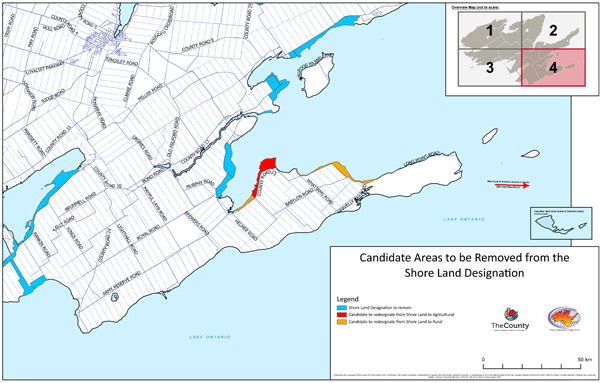Shorelands re-designation review launches with public meeting
Administrator | Oct 18, 2024 | Comments 0
Story and photos by Sharon Harrison
When the current official plan came into effect in 2021, a decision was made at the time to review the shorelands designation of the plan to notably determine two things.
At a public information meeting this week, around 80 local residents came out to the Wellington and District Community Centre where the municipality launched the review of the shorelands designation study.
The two areas County staff were directed to determine are those lands best suited for the shorelands designation, and whether the shorelands designation is needed at all, for certain properties.
In his presentation, Scott Pordham, the County`s policy co-ordinator, outlined details of the review, where he explained what the official plan is, what a shorelands designation is, and how the review may impact property owners.
 Pordham was joined by Michael Michaud, the County’s manager of planning. Also in attendance were councillors John Hirsch and Brad Nieman.
Pordham was joined by Michael Michaud, the County’s manager of planning. Also in attendance were councillors John Hirsch and Brad Nieman.
It was explained that because of the concerns raised in the 2021 official plan, an interim control bylaw came into effect in 2023 and was a temporary one-year prohibition on development on lands with shoreland designation for lack of natural heritage features in areas (with some exemptions).
A further one-year extension of the interim control bylaw was permitted, and is due to expire on May 23, 2025 (with no further extensions allowed under the planning act).
Ten candidate areas have been identified outlined in four maps: one in Hillier (Huyck’s Bay/Pleasant Bay/North Bay area), two in Ameliasburgh (Wellers Bay/Carrying Place and Massassuaga Point), two in Sophiasburgh (Big Island, Green Point, Grassy Point) two in North Marysburgh (Cressy Point/Adolphus Reach), two in South Marysburgh (Flatt Point, South Bay and Half Moon Bay), and one in Hallowell ward (Isaiah Tubbs Resort area).
The presentation was followed by a comment and question/answer period, and as well, attendees were able to more informally ask questions or express concerns at the end of the meeting with planning staff and councillors. Folks were also able to complete feedback forms.
In particular, Pordham explained the municipality is proposing to remove the shorelands designation in two areas outside the natural core areas where development would not normally be supported under the policies of the official plan.
 Those areas include the lands at the end of Cressy Point, and the lands across from County Road 12 near the Isaiah Tubbs Resort, where Pordham explained the proposed official plan amendment would change the designation of these two properties to either the agricultural designation or the rural designation.
Those areas include the lands at the end of Cressy Point, and the lands across from County Road 12 near the Isaiah Tubbs Resort, where Pordham explained the proposed official plan amendment would change the designation of these two properties to either the agricultural designation or the rural designation.
In particular, Pordham highlighted an old historical amendment to the official plan for a proposed golf course south-east of the Isaiah Tubbs Resort, to be re-designated to the agricultural designation.
“That never came to fruition, so staff feel it is appropriate to review as it’s been dormant for decades,” he said.
Noting that the property is currently available for a golf course, and has been for years and years, one questioner asked why a landowner would want the designation taken away from the property, and asked how it would affect the value of the property if it is re-designated, and who compensates the land owner.
Pordham said it would ultimately be council who will make the decision on whether it should be re-designated to agricultural.
“Given that it’s been sitting there for decades, and there has been no activity to develop a golf course there, staff`s initial thought was it should be removed,” he reiterated. “If it wasn’t in that shoreland designation, it would be in an agricultural designation to protect farming activities in that area, not just on the lot, but in the area.”
The landowner of the property being discussed piped up, saying, “When we bought the property, it was with the understanding that [designation] went with the property,” he said wanting to know who would compensate the land owner for the loss of the potential income.
Other questions from the public ranged from to whether a house can still be built if a piece of land is re-designated as agricultural (basic answer: yes), to how natural features are determined by the County, to a question about the appeals process.
One gentleman didn`t see the point of re-designating property to agriculture if it hasn’t been used as agriculture for years. “All those houses along County Road 13, there is no farming there anymore, except for one farm,” he said.
Another was concerned about whether she could build a house on a lot that is being re-designated as agriculture by this review, to which Pordham said, yes, she could.
“Land is regulated by the zoning bylaw; rural or rural residential still permits a house on the property, but setback requirements must be met,” Pordham confirmed, adding that the agricultural designation proposed doesn’t support tourist commercial uses, and also does not permit new residential severances. “If it’s an existing lot, the new designation status will not change.”
Another question came about whether a proposal for a draft sub-division already submitted for approval has to comply with the new designation, to which Pordham replied that if a draft plan of sub-division has previously been approved (and it hasn’t expired), it will still be allowed to proceed.
“You are still allowed to build on an existing severed lot, even if the shoreland designation changes it to something else, such as agricultural or rural,” he confirmed.
Another asked if the changes are precipitated by development requests, where Prodham said, no, they are being triggered because the official plan concerning shoreland designations were very permissive.
It was explained how the official plan identifies shorelands as an important resource that shall be managed in a way that promotes appropriate and sustainable development, with a focus on tourism, and enhancing public access to the waterfront.
“It is a planning tool the municipality uses, it provides policies to guide growth and development, how development can be controlled, what lands will be preserved from development, and so on.”
The official plan is considered when a property owner wants development that is not permitted by the existing zoning bylaw, he said. For example, if they want to re-zone their property to sever a lot, that’s when an official plan designation and a policy are considered by the municipality.
Describing what the shorelands designation is, Pordham explained that it is a designation within the official plan, and one that has existed for several decades. He noted that its original intent was to encourage tourist commercial and recreational uses.
“It was also, at one time, an area where residential sub-divisions could be developed as well, but today, the current designation permits residential uses (limited to single detached dwellings): it allows for existing agricultural uses, it allows for a wide range of resort commercial uses (tents, trailer parks, and other recreational vehicle parks), and it also permits marine commercial uses (such as docking, boating, storage, fuel facilities).”
Explaining why the shorelands designation is currently being reviewed, Pordham explained that at that time when the new official plan was passed, there were some concerns that the shoreland designation wasn’t compatible with some of the natural features and areas that were identified in that plan, “that maybe that designation wasn’t compatible with the concept or the principle of protecting some of those natural features”.
“We are looking at where the shoreland designation overlaps with the natural features in the areas, and we are looking at removing those lands from the shoreland designation, and moving it to either a rural designation or an agricultural designation.”
 Coming in two phases, the review begins with phase one with a mapping exercise this month, to be completed in January 2025.
Coming in two phases, the review begins with phase one with a mapping exercise this month, to be completed in January 2025.
First, for those properties that have a shorelands designation that overlaps with natural heritage features and areas (as identified in the official plan), an official plan amendment will be initiated to remove the shorelands designation from such properties. Affected property owners have already received notification from the municipality via regular mail.
“The municipality is proposing this change because certain uses permitted in the shorelands designation have a greater potential for adverse impacts on natural environment features, such as wetlands, significant woodlands and escarpments,” said Pordham.
“Shorelands support a broad range of land and water-based recreational, tourism-related commercial and residential uses, which will continue to be developed in a sustainable manner that protects water resources and shoreline features, as well as enhancing the public’s access to the water’s edge,” reminded Pordham.
Any proposed changes to the designation will not have any effect on property taxes, Pordham confirmed.
He also spoke to the impacts of the re-designation proposal and what it means, where it was explained that the official plan designation and its policies are considered when a property owner wants to develop something that is not permitted by the existing zone, or to sever a new lot.
“If you are fine with your existing zoning – perhaps you have a rural residential zoning with the zoning bylaw- what we are proposing to do through this study review, that’s not changing the zoning bylaw, so, what you are allowed to do on the property now, it will be the same thing under the attributes when we finish this study and we change parts of the official plan when it’s changed.”
He said, in terms of the rural policies and the agricultural policies, they are the two designations that are more common in the rural areas in the municipality.
“The rural policies, they still do allow first commercial uses, provided they meet some certain criteria, including one of them is that they are supposed to be near a rural resource.”
Rural designations still allows for consent to sever residential lots.
“It is not as permissive as the shoreland designation, but it is still fairly open. Where there would be more of a significant change would be the agricultural policies,” he said.
“The agricultural designation is more of a restrictive designation in an attempt to protect the best of farmland in the County. In the agricultural policies, tourist commercial uses are not supported, and also consent to sever new residential lots are also not supported.”
The second phase of the study, expected to run from January to May 2025, is to be more of a comprehensive review, to include an evaluation of the goals, objectives and policies of the shorelands designation, to consider the location and the extent of the designation.
Pordham noted how a comprehensive review of the designation will consider if the goals and objectives are still relevant and appropriate, and if the policies need to be updated.
It was noted that the shorelands designation review may also result in further changes to the schedules of the official plan, for example, land use designations, and recreation and tourism.
Next steps will involve the development of a draft official plan amendment in the next few months (considering public input received) with a public meeting (planning and development committee) expected in January.
Second phase study and draft official plan amendment will happen spring 2025, with a final public meeting anticipated in May 2025.
Further information on the shorelands designation official plan review can be found on the County`s Have Your Say page, where public input is encouraged in the next few weeks.
Filed Under: Featured Articles • News from Everywhere Else
About the Author:



































